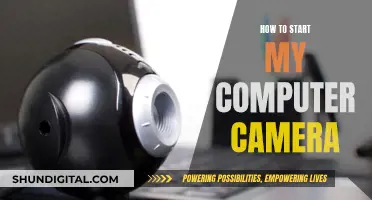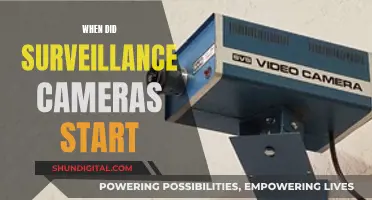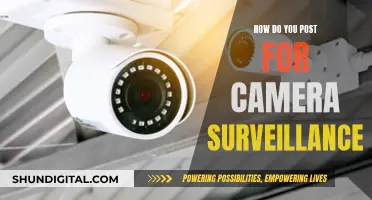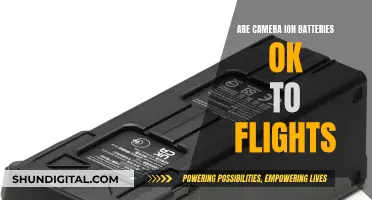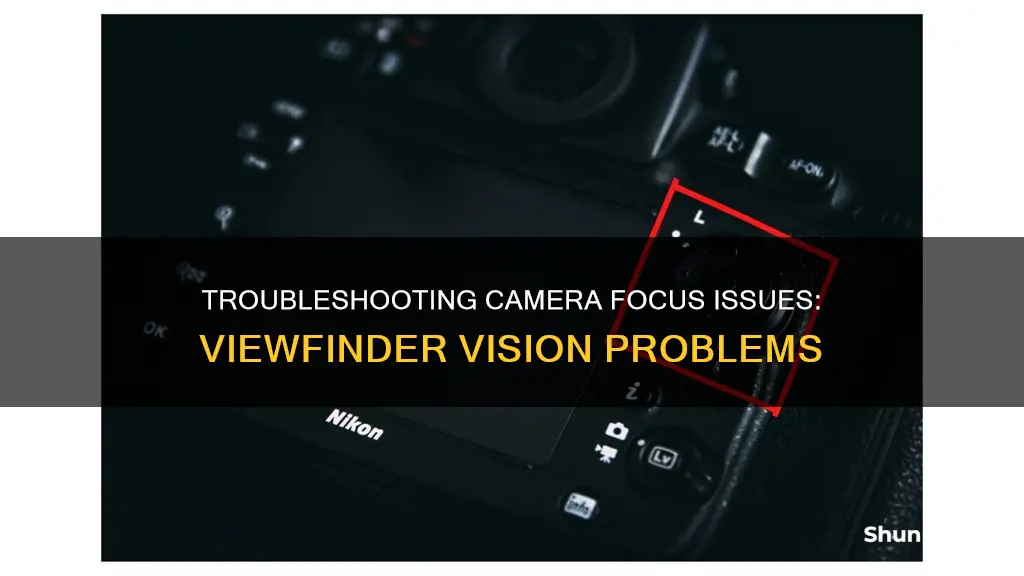
There are many reasons why your camera won't focus through the viewfinder. It could be that the lens isn't attached properly, the camera diopter needs adjusting, or the camera is struggling to focus due to low light or lack of contrast. If you're using autofocus, check that it's activated and that your lens is set to a minimum focus distance. If you're still having issues, try switching to manual focus or using live view.
| Characteristics | Values |
|---|---|
| Camera diopter | Incorrectly set |
| Autofocus | Not selected |
| Lens | Not attached properly |
| AF/M switch on the lens | Not set to AF |
| Focus point | Not aimed at an area of contrast |
| Minimum focus distance | Too close to the subject |
| Lighting conditions | Too dark |
What You'll Learn

Check the viewfinder diopter
If you're having trouble focusing your camera through the viewfinder, it's common to suspect that your lens has focus issues. However, the diopter is usually the culprit. Diopter adjustments are a critical step in ensuring that your view through the viewfinder is clear and not blurry.
Most cameras with optical and electronic viewfinders allow you to adjust the viewfinder's focus to match your vision. This is known as diopter adjustment. Diopters correct for minor near- and farsightedness; they don't compensate for astigmatism.
To check the viewfinder diopter, follow these steps:
- Locate the diopter control: The diopter is generally a small wheel, dial, slider, lever, or knob close to the camera's viewfinder. Most are labelled with + and - signs.
- Mount the camera: Place the camera on a tripod and point it towards a bright, featureless subject, such as a light wall, the sky, or a flat scene with decent detail and good contrast, such as a bookshelf or a clock.
- Focus the camera: If you have an autofocus camera, activate the autofocus. If you have a manual focus camera, attempt to focus the image using electronic focus indicators if available.
- Adjust the diopter: Look through the viewfinder and rotate the wheel or move the slider until the viewfinder symbology (grid, exposure information, focus points, digital data, etc.) comes into sharp focus. This includes the numbers, letters, and gridlines displayed in the viewfinder, not the scene in front of the camera.
- Repeat as necessary: If you always photograph with glasses or contacts, wear them when setting the diopter. If you prefer to photograph without glasses or contacts, remove them before adjusting the diopter.
By adjusting the viewfinder diopter, you can ensure that the view through the viewfinder is clear and sharp, allowing you to compose your shots accurately and capture the best possible photos.
Square Mode Photography: Capturing Unique Moments with a Twist
You may want to see also

Try autofocus instead of manual focus
If your camera won't focus through the viewfinder, it could be because you've forgotten to switch back to autofocus. There is usually a small switch on your lens that lets you toggle between autofocus and manual focus. On some Nikon cameras, there may be an "AF/MF" switch on both the lens and the camera body.
Autofocus is great when you're starting out, working on your own, or shooting very fast-moving subjects. It's also useful when you're making documentaries or anything that might be unpredictable, as it lets the camera take control.
If you're shooting in low light, your camera may struggle to locate a focal point and will hunt or "peck" around for one. It's much easier, therefore, to switch to autofocus and let the camera do the work for you.
Autofocus is also a good option if you're shooting solo and want to concentrate on getting other elements of your video right. It can also be a huge help when shooting fast-moving subjects, as it's sometimes impossible to adjust the focus quickly enough manually.
If you're shooting through glass or shooting a subject behind wire fencing, autofocus is a better option as it can detect the contrast needed to focus, whereas the human eye may struggle to see this.
If you're shooting in a studio, autofocus can be useful as it allows you to concentrate on other elements of photography, such as exposure and lighting, without splitting your attention.
Autofocus is also ideal for vlogging or self-shooting, as it can be tricky to set your focus manually and film yourself at the same time.
If you're shooting a subject that is mostly a uniform black surface, your lens may struggle to focus and will focus hunt. In this case, autofocus is a better option as it will be able to detect the contrast needed to focus.
If you're shooting video, especially if you're on the move, autofocus is a good option as it can be tricky to adjust the focus manually while filming.
If you're shooting with vintage lenses, autofocus may be a better option as it can be very difficult to focus manually through an electronic viewfinder.
If you're shooting with a tripod, it's a good idea to use autofocus to lock in your focus, especially if you know exactly where the focus is going to be and your subject remains still.
If you're shooting with a mirrorless camera, autofocus is a better option as the focusing screens on modern DSLRs are not designed for manual focusing and are subpar tools for the job.
If you're shooting with a DSLR, it can be tricky to focus manually through the viewfinder, and it's easy to miss the focus. In this case, switching to autofocus can help you get the shot.
If you're shooting with a modern autofocus camera, it may have excellent autofocus capabilities and may be able to do a better job than you can manually.
If you're shooting with a camera that has a touch screen, this feature can only be used in conjunction with autofocus mode, so you'll need to switch to autofocus to use this function.
If you're shooting with a Sony camera, it may have a feature that allows you to pre-focus by holding the shutter halfway down to lock the focus and then firing the shot. This is a useful autofocus feature that can help you get the shot.
If you're having trouble focusing through the viewfinder, it's a good idea to try switching to autofocus to see if that solves the problem.
Charging the Kodak Easyshare C1450: A Simple Guide
You may want to see also

Adjust the lens distance
If you're having trouble focusing your camera through the viewfinder, there are a few things you can try. Firstly, check that you are not too close to your subject. All lenses have a specific minimum focusing distance, so if you're too close, you may need to take a couple of steps back and try refocusing.
Another thing to check is your diopter adjustment. Most cameras with optical and electronic viewfinders allow you to adjust the viewfinder's focus to match your vision. This is known as a diopter adjustment and it's a critical step in ensuring that your view through the viewfinder is clear and not blurry. Diopter adjustments are especially useful if you wear corrective glasses, as they allow you to shoot without glasses. To adjust your diopter, locate the diopter adjustment control, which is typically a small circular dial or linear switch near the viewfinder. Turn on your camera and remove the lens cap, if there is one. Look through the viewfinder and point the camera towards a bright, featureless subject, such as a light wall or the sky. Relax your eyes and half-press the shutter button to activate the data display within the viewfinder. Adjust the diopter control back and forth until the data displayed in the viewfinder (such as numbers, focus markers, and gridlines) comes into sharp focus.
If you wear glasses, adjusting the diopter can make your photography experience more pleasant and hassle-free. Adjusting the viewfinder to match your uncorrected vision will also help you identify autofocus errors before taking a picture, as you will be able to see the most acute possible rendition of the scene in the viewfinder.
Polaroid Cameras: Still Being Made, Still Capturing Moments
You may want to see also

Check for low light or low contrast
If your camera won't focus through the viewfinder, it could be due to low light or low contrast. Here are some tips to address these issues:
Check for Low Light:
- Use a torch or another light source to illuminate your subject. Once the subject is in focus, switch to manual focus mode to prevent the camera from trying to refocus when you press the shutter release.
- Use a lens with a larger maximum aperture, such as f/1.8 or f/2.8, as these allow more light to reach the camera's autofocus system.
- Utilize your camera's focus assist light (if available) to aid in low-light focusing.
- When shooting in low light, select the center focus point, as it is typically the most accurate and strongest option among the cross-type autofocus (AF) points.
Check for Low Contrast:
- Aim your focus point at an area of contrast. Cameras use contrast to determine the subject and need it to be able to focus the lens. Look for a line or part of the scene with a contrast between light and dark areas and place your focal point there.
- When using the '"focus-and-recompose" technique, ensure you have achieved focus before recomposing your image. Press the shutter button halfway down to focus, keep the same pressure, recompose, then fully press the shutter button to take the photo.
- Use the center focus point, as it is a 'cross focus point' and can find contrast in two directions, making it more accurate.
- Avoid using Servo modes in low light, as they can be inaccurate and unreliable due to fewer areas of high contrast. Instead, manually find your point of focus.
Overcharging Camera Batteries: What are the Risks and Consequences?
You may want to see also

Try a different lens
If your camera won't focus through the viewfinder, one possible solution is to try a different lens. This is because the lens and camera must be in proper communication with each other to function properly. If the lens isn't attached properly, the metal contacts on the camera and lens may not be touching, preventing the camera from sending the lens the message to focus when you press the shutter button.
To check if this is the issue, remove the lens and remount it, listening for a small click to indicate that it's locked into place. If you still can't focus through the viewfinder, try switching the lens to manual focus and back again to autofocus. If the problem persists, it's likely an issue with the camera body rather than the lens.
In addition to trying a different lens, you can also try the following troubleshooting tips:
- Check your viewfinder diopter and fine-tune the dial to get a clear image in your viewfinder.
- Switch back to autofocus from manual focus.
- Ensure you are not too close to your subject, as all lenses have a specific minimum focusing distance.
- Use the center focus point, which is the most accurate as it can find contrast in two directions.
- If you're shooting in low light, use a lens with a larger maximum aperture to let in more light.
The Evolution of Cameras: A Historical Timeline
You may want to see also
Frequently asked questions
There could be a few reasons for this. Firstly, check that your lens is attached properly. If it's not locked into place, the metal contacts on the lens and camera won't be touching, meaning the camera can't send a message to the lens to focus. Secondly, check that your autofocus is on – locate the AF/M switch on the lens and make sure it's set to AF. If your camera has a focus switch, make sure this is also set to autofocus. If you've tried these things and your camera still won't focus, try adjusting the diopter – a small wheel or slider close to the viewfinder. This will help you match the focus of your viewfinder to your eye. If you wear glasses, the diopter can be used to correct your vision so you can shoot without them.
There is a difference between autofocus when using the viewfinder and when using live view. Live view uses the image sensor to acquire the correct focus, whereas there is a separate focusing sensor that is used when using the viewfinder. The problem could be that the focusing sensor isn't receiving enough light to acquire focus. Try shooting in better light or with a lens that lets in more light.
This could be to do with your autofocus settings. Check your custom settings and make sure autofocus is enabled. You could also try changing the lens AF point. If this doesn't work, try using a different lens. If the problem persists, it's likely an issue with your camera.
If you can hear the lens working when you press the button, but the camera still won't focus, the issue could be that you're too close to your subject. Every lens has a minimum focus distance – check the specs of your lens to find out what this is, and try moving further away from your subject.
If you can see a clear image on your screen, it's likely that your diopter is set incorrectly. Adjust the diopter until the viewfinder looks sharp. Remember that the diopter won't affect the sharpness of your photos, only the sharpness of the viewfinder.


